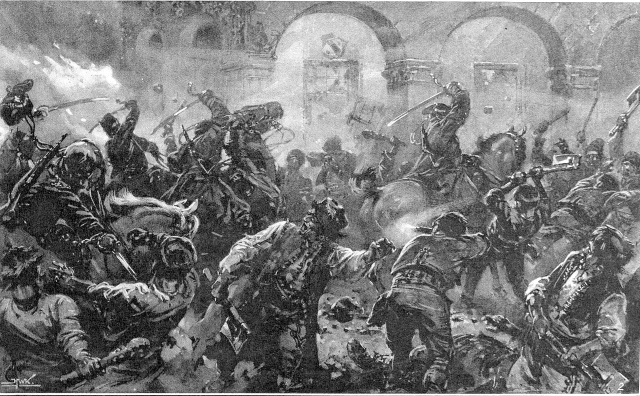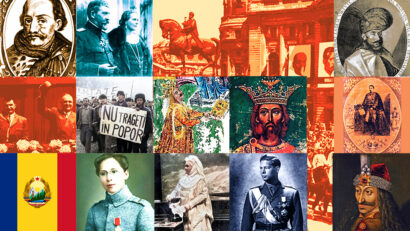110 years since the Peasants’ Uprising in 1907
This year Romania marks 110 years since the bloody Peasants' Uprising of 1907

Steliu Lambru, 20.02.2017, 14:08
Romania was unwaveringly heading towards modernization and European integration, early into the 20th century. In the 19th century, elites and society opted for political, social and cultural emancipation, in a bid to rid themselves of the outmoded habits. Against that triumphalist backdrop, in February 1907 a large-scale social explosion occurred in the rural world, known as the Peasants’ Uprising of 1907. Its impact on Romanian society was very strong, and the uprising also came to be known abroad.
Historian Alin Ciupala teaches modern Romanian history at the History Faculty with the University of Bucharest. Professor Ciupala emphasized the importance of the shock the uprising generated, in stark contrast with Romania’s ambition to become a modern European country.
Alin Ciupala: ”The uprising was perceived as a great shock in its time, because the scale of the event was unprecedented. In 1906 not long before the uprising, Romania had staged the Jubilee exhibition, which had its own impact abroad. The exhibition was conceived as some sort of a conclusion, an appraisal of the progress Romanian society had made since 1866, the year when the future kind Carol of Hohenzollern-Sigmaringen had arrived in Romania, and the date when the Constitution had been voted in Parliament, laying the foundations of the constitutional monarchy as a political system. In a rather limited time span, on one hand, we have the achievements, all the positive things that had been achieved for 40 years in Romania, while on the other hand we have the failures, a mirror of the limits of the system”.
Farming work was undervalued and economic efficiency was poor. Added to that was the absence of work ethics, illiteracy and alcoholism, while leaseholders took advantage of all the flaws and vices peasants may have. The uprising sparked off in northern Moldavia in the commune of Flaminzi, which was at that time an agrarian area. On March 9th, the uprising ignited in the southernmost regions of Oltenia and Wallachia, while in late March it was quashed with the help of the army.
Enraged peasants attacked the leaseholders’ properties, and in some regions they even stormed boyars’ houses, killing people and setting houses and goods on fire. There were voices that said that rioters went way too far with their claiming actions. According to famous writer I. L. Caragiale, “the peasants’ action had the proportion of a downright terrorist revolution, it nearly had the scale of a fearsome civil war.“ The uprising also saw clashes between groups of rebellious peasants and the peasants who refused to get involved in violent action.The agrarian issue was a highly critical one, yet it was not the main cause of the events that sparked off the uprising. With details on that, here is historian Alin Ciupala once again.
Alin Ciupala: “Romanian historiography pointed to severe land shortage in rural regions as the main cause of the uprising. As far as I’m concerned, the causes of the uprising need to be linked to a much more complex phenomenon, namely the fact that the system was not functional at the bottom level. We deal with a corrupt local administration that had the mission to protect the peasants from abuse of all kind. Peasants are in fact left to fight by themselves a bureaucratic system that they cannot understand or deal with. So they had no choice but to make their desperation known through an uprising. What they wanted was to raise awareness, in a violent manner, over this problem, which the elites knew all too well but which they were unable to solve. And this is a constant paradox of the Romanian society – the problem is known, but there is an inability to put into practice solutions that are found in theory.”
Alin Ciupala commented on several interpretations given to the uprising, such as its anti-Semitic character or its foreign origins:
Alin Ciupala: “When an explanation for the uprising was looked for, there were intense discussions about the role that the Jews had played in it. The uprising of 1907, just like the Dreyfuss business in France, was a moment that surfaced the Romanian anti-Semitism, a latent one, which did not take violent forms. The Jews were considered guilty for the uprising, due to the abuse that the Jewish landowners in Moldova made over the peasants. Nobody cared to think about the fact that most landowners were Romanian and not Jewish. There were also some absurd explanations, such as the fact that the Austro-Hungarian or Russian intelligence services had organized the uprising in order to create social unrest in Romania. That was also a false scenario. The uprising indicated a problem of the Romanian society, a very serious problem that was not solved in the inter-war period either.”
Documents read that the quelling of the peasants’ riot made 11,000 victims. Alin Ciupala told us more about how the figure was estimated.
Alin Ciupala: “That figure was published that very day in the ‘Adevarul’ and ‘Dimineata’ leftist newspapers, run by the socialist Constantin Mille. This is a figure that actually is not supported by anything. The Communist regime took it over without checking. In 1977, Ceausescu organized a peasants’ congress, inviting 11,000 delegates to mark the number of the victims in 1907. It’s very difficult to say how many people died then and we will probably never know for sure. The Interior Minister Ionel Bratianu took files containing the results of the investigation conducted by authorities, which had been very thorough, and gave them to the king when the National Liberal Party no longer governed the country. Bratianu knew that his conservative opponents would use those files to hit him. Unfortunately, those files are lost. According to my estimates, based on the 1907 register of deaths, there probably were some 2000 victims. But what matters is not that 11,000 or 2,000 died, but the fact that people died in a society that was advancing towards modernization only because the bureaucratic apparatus was not capable of solving a very serious issue.”
The 1907 revolt showed that the state, although it had made serious progress, still needed a lot to recover. But also true is the fact that the Romanian rural world was rather reluctant to change.






























